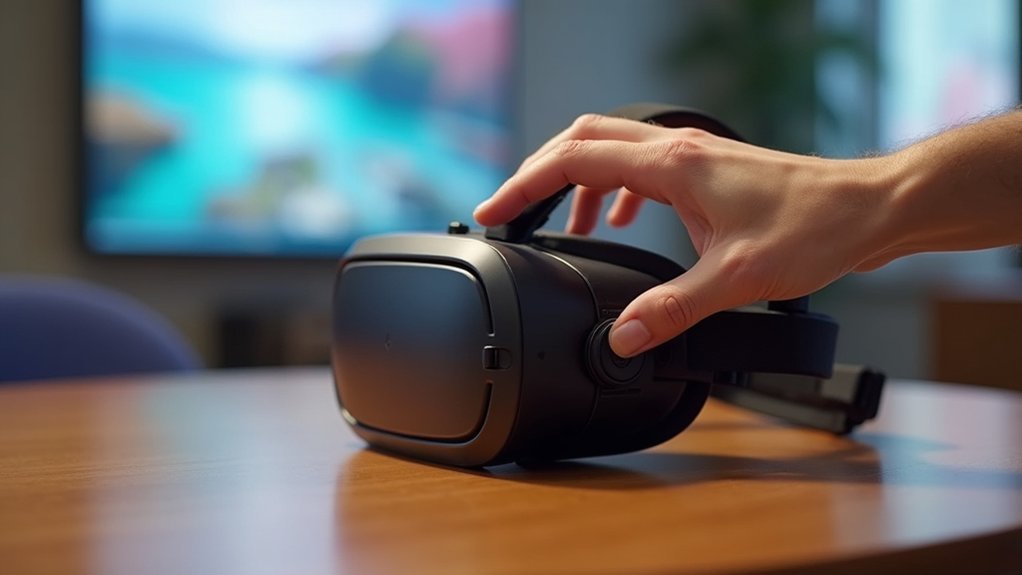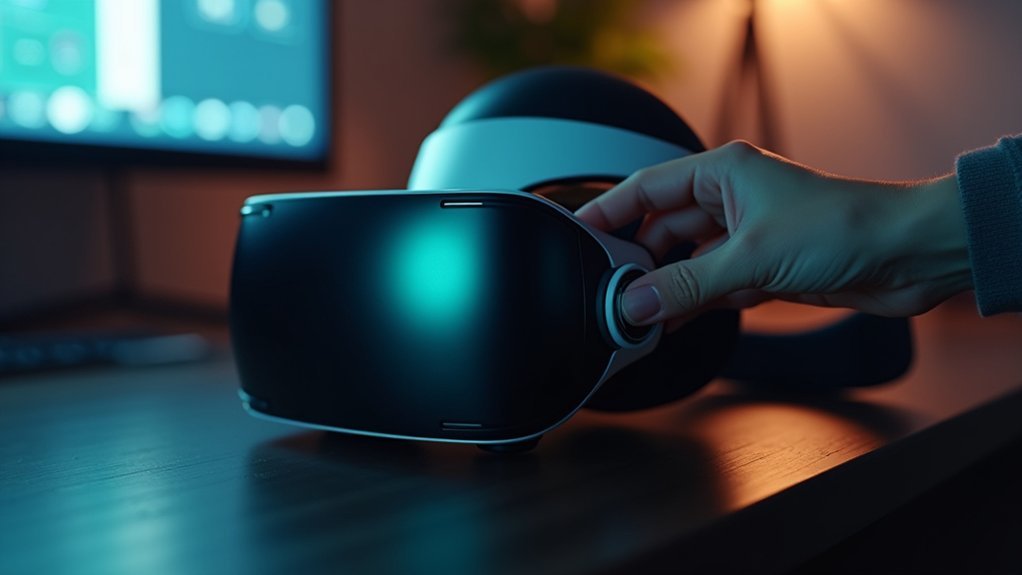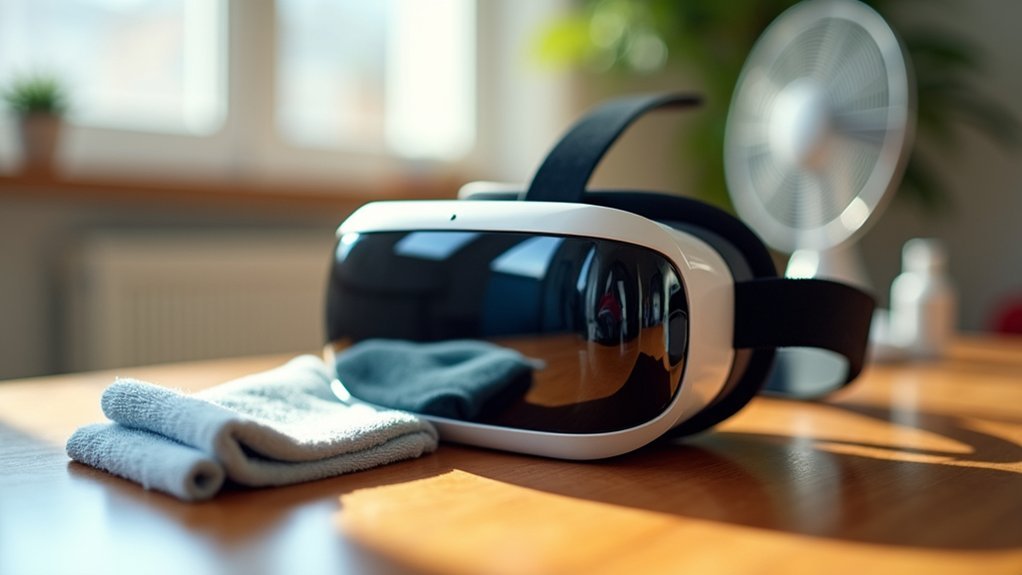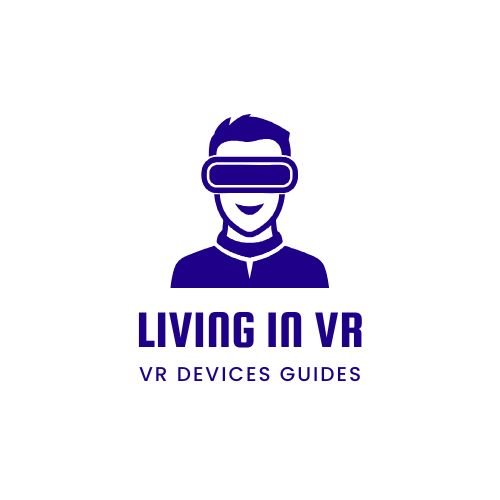You can quickly relieve VR eye strain by adjusting your headset’s IPD settings to match your interpupillary distance and optimizing lens-to-eye distance for clarity. Take breaks every 20 minutes using the 20-20-20 rule, focusing on distant objects for 20 seconds. Lower your screen brightness, practice intentional blinking, and perform eye exercises like rolling your eyes in circles. Keep lenses clean with a microfiber cloth, guarantee proper ventilation, and apply preservative-free lubricating eye drops before sessions. These techniques will help you discover even more comfort strategies.
Adjust Your Headset’s Interpupillary Distance (IPD) Settings

When your VR headset feels uncomfortable or causes eye strain, adjusting the Interpupillary Distance (IPD) settings should be your first step toward relief.
Most VR headsets accommodate different users with IPD adjustments ranging from 58mm to 72mm, matching the average distance between your pupils. Proper IPD alignment guarantees the lenses align perfectly with your eyes, dramatically improving visual clarity and reducing fatigue during extended sessions.
You’ll need to experiment with different settings to find your sweet spot. When your interpupillary distance matches the headset’s configuration, images converge correctly, minimizing discomfort and preventing headaches.
Misaligned settings cause blurred images and increased eye strain. Check your manufacturer’s manual for specific adjustment instructions, as each VR headset model features different mechanisms for IPD calibration.
Take Regular Breaks Using the 20-20-20 Rule
You’ll find the 20-20-20 rule becomes your best defense against VR eye strain when you understand its simple but effective approach.
Implementing this practice during your virtual sessions means pausing every 20 minutes to focus on something 20 feet away for 20 seconds, giving your eyes the reset they desperately need.
You can enhance these mandatory breaks by combining eye exercises with other comfort strategies that’ll keep you gaming longer without the fatigue.
Understanding the Rule
While VR headsets transport you to incredible digital worlds, they can strain your eyes if you don’t take proper precautions. The 20-20-20 rule offers a simple solution to combat eye strain during your VR sessions. This straightforward guideline works by following three key numbers: every 20 minutes, take breaks for 20 seconds while looking at something 20 feet away.
When you’re immersed in virtual environments, your eye muscles work overtime focusing on close-up screens. This prolonged focus creates fatigue that leads to discomfort.
The 20-20-20 rule helps relax these overworked muscles by shifting your focus to distant objects. By consistently applying this practice, you’ll reduce symptoms like headaches, sore eyes, and temporary vision problems while enhancing your overall VR experience.
Implementation During VR
Putting the 20-20-20 rule into practice during your VR sessions requires setting up a simple reminder system. Use your phone’s timer or VR app notifications to alert you every 20 minutes. When the alert sounds, immediately remove your headset and focus on something 20 feet away for 20 seconds.
| Without 20-20-20 Rule | With 20-20-20 Rule |
|---|---|
| Persistent eye fatigue | Enhanced eye comfort |
| Painful headaches | Clear, refreshed vision |
| Session cut short | Extended playtime |
This practice combats eye fatigue by relaxing your eye muscles and encouraging natural blinking. You’ll notice improved eye comfort and can enjoy longer virtual reality sessions without discomfort. The brief interruptions seem minimal but deliver significant relief, transforming your VR experience from potentially painful to consistently enjoyable.
Enhanced Break Strategies
Although basic 20-20-20 implementation provides immediate relief, enhanced break strategies can maximize your eye comfort and VR performance.
You can optimize the 20-20-20 rule by incorporating additional techniques that protect your eye health during extended sessions.
Consider these enhanced approaches for Regular Breaks to Rest:
- Set multiple timer intervals to guarantee consistent break frequency
- Combine distant viewing with gentle eye exercises like blinking and rolling
- Use break time to hydrate and adjust your VR headset positioning
- Practice focusing on objects at varying distances during breaks
- Dim room lighting before returning to VR to reduce contrast shock
These strategies greatly reduce eye irritation beyond standard break protocols.
You’ll notice improved comfort and sustained focus throughout longer VR experiences when implementing these thorough break techniques.
Optimize Lens-to-Eye Distance for Comfortable Viewing
You’ll want to locate your headset’s eye relief buttons or adjustment mechanisms to customize the lens-to-eye distance for your specific needs.
Start by adjusting these controls while wearing the headset to move the lenses closer or farther from your eyes.
Experiment with different positions until you find the sweet spot where the image appears sharp and your eyes feel comfortable without pressure.
Adjust Eye Relief Buttons
Finding the ideal lens-to-eye distance transforms your VR experience from uncomfortable to immersive. Eye relief buttons on VR headsets let you fine-tune this essential distance, preventing eye strain and visual discomfort that can ruin your session.
Most modern VR headsets feature adjustable eye relief mechanisms that accommodate different facial structures and users who wear glasses. You’ll want to experiment with various settings to discover your best lens distance.
Here’s how to adjust eye relief effectively:
- Start with the closest comfortable setting and gradually move outward
- Test different positions while viewing VR content, not just menus
- Verify text remains sharp and clear at your chosen distance
- Check that your field of view isn’t unnecessarily restricted
- Confirm glasses fit comfortably without touching lenses
Proper adjustment enhances immersion while protecting your eye health.
Find Optimal Distance
Once you’ve mastered the mechanical adjustments, the real challenge begins: discovering your personal sweet spot for lens-to-eye distance.
Start by positioning the lenses at a moderate distance from your eyes, then gradually experiment with different settings. You’ll know you’ve found the right distance when text appears sharp and images come into crisp focus without causing eye strain.
A comfortable fit means you can enjoy extended VR sessions without fatigue or discomfort.
Pay attention to how your eyes feel during use – any squinting or pressure indicates you need further adjustment. The ideal lens-to-eye distance varies between users, so take time to find what works specifically for you.
Remember to recalibrate these settings if others use your headset.
Lower Screen Brightness and Adjust Display Settings

Since excessive screen brightness is one of the primary culprits behind VR eye strain, adjusting your headset’s display settings should be your first line of defense.
When you lower screen brightness to a comfortable level, you’ll immediately reduce discomfort and prevent headaches during extended sessions.
Most VR headsets offer customization options that enhance visual comfort:
Modern VR systems include built-in display customization features specifically designed to reduce eye strain and improve user comfort during gameplay.
- Set brightness without causing glare or excessive intensity
- Adjust contrast levels to reduce focusing effort
- Use warmer color tones to minimize blue light exposure
- Calibrate color settings for personal comfort
- Regularly fine-tune settings based on your needs
When you adjust display settings properly, your eyes won’t work as hard to process visual information.
This simple modification can markedly extend your VR sessions while maintaining comfort and preventing fatigue.
Practice Intentional Blinking and Eye Exercises
Incorporate deliberate blinking and targeted eye exercises into your VR routine to combat dryness and muscle tension that naturally develop during immersive sessions. Intentional blinking every few minutes stimulates natural tear production, keeping your eyes moist and reducing the discomfort that accompanies prolonged VR use. This simple practice directly addresses one of the most common sources of eye strain.
Implement the 20-20-20 rule by pausing every twenty minutes to focus on something twenty feet away for twenty seconds. This technique relaxes your eye muscles and prevents fatigue.
Additionally, perform eye exercises like rolling your eyes in circles or alternating focus between near and far objects to improve muscle flexibility and enhance overall comfort during extended sessions. Regular practice maintains eye health and prevents long-term complications.
Clean Your Lenses and Use Proper Ventilation

While pristine lenses dramatically improve your VR experience, dirty or foggy optics force your eyes to work harder and create unnecessary strain.
Clean your lenses regularly with a microfiber cloth to maintain crystal-clear vision. Avoid using clothing or rough materials that can scratch the delicate surface of your VR lenses.
Microfiber cloths preserve lens clarity while harsh materials cause permanent scratches that compromise your VR visual experience.
Proper ventilation is equally important for comfortable sessions:
- Use a fan to improve air circulation around your play area
- Keep your headset in shaded areas when not in use
- Store with lens covers to prevent dust accumulation
- Maintain a cooler environment to prevent fogging
- Guarantee adequate airflow to reduce sweat buildup
These simple maintenance habits will reduce eye fatigue and enhance visual clarity.
Clean lenses combined with proper ventilation create ideal conditions that help reduce eye strain during extended VR sessions.
Apply Lubricating Eye Drops Before and After VR Sessions
Though your eyes naturally produce tears to stay moist, VR headsets can disrupt this process and leave you with dry, irritated eyes.
Applying lubricating eye drops before and after VR sessions creates a protective barrier on your eye surface, enhancing comfort and reducing the risk of eye strain. Choose preservative-free options to avoid potential irritation during your activities.
Regular use helps maintain proper moisture levels, countering the drying effects of air circulation and reduced blinking while you’re immersed in virtual worlds.
These drops effectively combat the uncomfortable symptoms that can plague extended VR sessions.
For ideal eye health, consult an eye care professional who can recommend suitable lubricating eye drops tailored to your individual needs and specific eye conditions.
Frequently Asked Questions
How to Make VR Safe for Eyes?
Adjust your headset’s IPD settings to match your eye separation. Take regular breaks using the 20-20-20 rule. Maintain proper fit, guarantee good lighting, and use fans for circulation to prevent strain.
How to Fix Vision on VR?
Adjust your headset’s IPD settings to match your pupil distance, fine-tune the lens positioning wheel, and experiment with brightness and contrast controls. Consider prescription lens inserts if you wear glasses.
How Long Does It Take for Your Eyes to Get Used to VR?
Your eyes typically take a few hours to a couple days to adjust to VR, depending on your sensitivity. You’ll likely experience initial strain, but it’ll resolve with gradual exposure and regular breaks.
How to Reduce VR Fatigue?
Take frequent 20-30 minute breaks, adjust your IPD settings properly, follow the 20-20-20 rule, optimize display brightness and contrast, and practice intentional blinking with palming techniques to reduce fatigue.





Leave a Reply